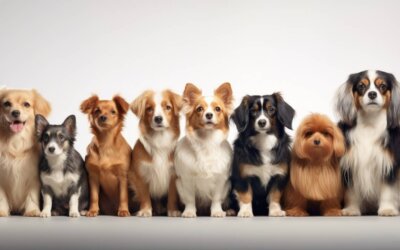As we watch our dogs sleep, we’ve likely wondered: What do dogs dream about? The notion of our loyal companions experiencing nighttime adventures in their slumber is both fascinating and mysterious.
Like humans, dogs enter a world of dreams when they sleep, but what happens has intrigued pet owners and scientists alike. In this exploration, we journey into the enigmatic realm of canine dreams.
The Science of Dog Sleep
Do Dogs Dream? Yes, And here is how
The science of sleep plays a pivotal role in this revelation. Like humans, dogs undergo different stages of sleep, including the Rapid Eye Movement (REM) phase, known for its association with dreams.
While we may be unable to ask our furry companions about their dream experiences, scientific evidence suggests that dogs dream during REM sleep. But what influences the content of their dreams?

What Influences Dog Dreams?
To decipher the canine nighttime imagination, we must delve into what influences the content of dog dreams. Dogs share everyday experiences with humans during their waking hours, and these experiences often find their way into their dreams.
Elements from daily life, such as interactions with family members, other pets, or encounters in the park, can shape the landscape of their dreams. Additionally, instinctual behaviors rooted in their evolutionary history, like chasing prey or exploring territory, can play a significant role in their dream narratives.
Signs That Your Dog Is Dreaming
One of the most evident signs of canine dreaming is their body movements. During dreams, dogs may twitch, paddle their legs, or make subtle movements as if engaged in some activity. These motions mirror the actions they might take when awake, offering a glimpse into the content of their dreams.
The Role of Rapid Eye Movement (REM) Sleep
REM sleep is a critical phase in the sleep cycle, not only for humans but also for dogs. It’s during this phase that dreams are believed to occur. Rapid eye movements in humans characterize REM sleep, and this pattern also extends to dogs.
If you’ve ever noticed your dog’s eyes moving rapidly beneath their closed eyelids, it’s a strong indicator that they are in the midst of a dream. This fascinating connection between REM sleep and dreaming provides valuable insights into the canine mind.
What Do Dogs Dream About?
Theories on Canine Dream Content
The mysterious world of canine dreams has long captured the curiosity of dog owners and researchers alike. While we can’t directly ask dogs about their dreams, several theories shed light on what may be happening in their slumbering minds.
One prevalent theory suggests that dogs dream about activities and experiences from their daily lives. Imagine your dog running joyfully in the park or playing fetch with unwavering enthusiasm. These moments define their daily routines, and these joyful encounters likely find their way into their dreamscape.
Another theory suggests that the dreams of dogs might be influenced by their ancestral instincts. They may relive everyday habits and activities shared with their ancient ancestors in their dreams, such as hunting.

Do Dogs Have Nightmares?
While dogs undoubtedly dream, just as humans do, the emotional content of these dreams remains a subject of inquiry. Behavioral cues during sleep, such as whining, whimpering, or growling, suggest that dogs can experience dreams with harmful emotional elements akin to nightmares.
The causes of these potential nightmares can vary. Dogs may recall past traumatic experiences, process fear-inducing situations, or even respond to physical discomfort or illness.
As responsible pet owners, we must recognize the signs of distress in our furry companions and respond with care. Offering a soothing presence, gentle petting, or comforting words can go a long way in alleviating their distress and providing emotional support during troubling dreams.
Promoting Healthy Sleep
Creating a Comfortable Sleep Environment
Ensuring your dog has a comfortable sleep environment is crucial for their well-being. Just like humans, dogs benefit from a cozy and peaceful resting place. Consider the following factors to create an ideal sleep environment:
Comfortable Bed 🛏️
Choose a bed that matches your dog’s size and sleeping preferences, whether they prefer soft cushions or orthopedic support.
Appropriate Room Temperature 🌡️
Maintain a comfortable room temperature, as dogs are sensitive to extreme heat or cold. Adjust as necessary to create a pleasant sleep environment.
Minimal Noise and Disturbances 🔇
Dogs sleep best in a quiet, calm space. Use white noise machines or calming music to mask disruptions if needed.
The Role of Exercise and Mental Stimulation
Regular exercise and mental stimulation play a significant role in promoting healthy sleep for dogs. Consider these factors:
Physical Activity
Engage your dog in regular physical activities like walks, playtime, and fetch sessions. Physical exercise helps them expend energy, making them more likely to enjoy restful sleep.
Mental Stimulation
Mental exercises like puzzle toys, training sessions, and interactive games are essential to keep your dog’s mind active. Mental stimulation can tire out your dog mentally, contributing to a contented and sleepy pooch at bedtime.
Monitoring Your Dog’s Sleep Patterns
Observation
Pay attention to your dog’s sleep behaviors. Note any changes in their sleep, such as restlessness, excessive movements, or increased vocalizations, which could indicate discomfort or distress.
Consistency
Try to establish a consistent sleep routine for your dog. This can include regular bedtimes and wake-up times, which can help regulate their internal body clock.
Consulting a Veterinarian
If you notice significant changes in your dog’s sleep patterns, especially if accompanied by other concerning symptoms, consult with a veterinarian. Changes in sleep patterns can sometimes be linked to underlying health issues.
So, the next time you watch your dog sleep and wonder what adventures are unfolding in their dreams, remember that by fostering a healthy sleep routine, you’re nurturing their physical and emotional health while sharing the mysteries of their nighttime imagination.

FAQs About What Dogs Dream About
Can I influence what my dog dreams about through their daily activities?
You can indirectly influence your dog’s dream content by engaging in specific activities with them. Playing fetch might lead to dreams of chasing a ball, while a day at the beach could result in dreams of running through the sand. Your interactions and experiences with your dog can shape their dreamscapes.
Can dogs dream of people or other animals they’ve never met?
Dogs are capable of dreaming about both familiar and unfamiliar beings or animals. Their imaginations, instincts, and the various stimuli they encounter in their environment can influence their dreams.
Can my dog’s breed affect the content of their dreams?
While breed-specific traits may influence the content of a dog’s dreams to some extent, individual experiences play a more significant role. For example, a Border Collie may dream of herding, but a Labrador might dream of retrieving.
Do Dogs Dream of Their Owners?
While we can’t know, research suggests that dogs dream like humans. They likely dream about familiar experiences, including interactions with their owners, places they’ve been, or activities they enjoy.
What Do Dogs Dream About When They Twitch?
While it’s impossible to know precisely what dogs dream about, scientific evidence suggests their dreams might be similar to ours. When dogs twitch or move during sleep, they’re likely experiencing a dream. These dreams involve activities from their daily lives, like playing, running, or interacting with people or other animals.
Do Dogs Remember Their Dreams?
While confirming whether dogs dream like humans is challenging, they experience sleep cycles that include REM (rapid eye movement) phases when dreaming usually occurs. Observations suggest that dogs may dream about activities and experiences from their daily lives.






I’ve often wondered if my dog is chasing squirrels in her dreams. Sometimes she barks and twitches in her sleep. It’s adorable and fascinating. Do dogs have nightmares too? I hope not!
I’ve always wondered what’s going on in my dog’s head when he’s dreaming